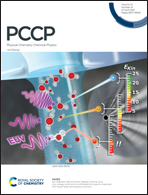Antiaromaticity–aromaticity transition of cyclo[16]carbon upon metal encapsulation†
Abstract
In contrast to aromatic compounds with particular stability, antiaromatic compounds are usually less stable due to their high reactivity and unfavorable formation energies. Cyclo[16]carbon (C16) is a carbon ring molecule with a dual antiaromatic character. In this study, we demonstrate that C16 can be transformed into highly aromatic molecules upon metal encapsulation. The geometrical characteristics, electronic properties and thermodynamic stability of MC16 compounds (M = Ca, Sc, Ti, V, Ce, U) are fully investigated from a theoretical perspective. Based on natural population analysis, atom-in-molecules theory and localized molecular orbital analysis, the nature of the metal–carbon interaction in the MC16 compounds is investigated. It has been proved that the bonding between Ca and C16 corresponds to a typical ionic interaction, while other metal atoms form polar covalent bonds with C16. By analyzing the frontier molecular orbitals and magnetic response of MC16, we have found that all the encapsulated metal atoms donate two electrons to the in-plane π orbitals via either electron transfer or orbital hybridization, which makes the in-plane π orbitals completely satisfy the 4n + 2 (n = 4) Hückel aromaticity rule. The U atom formally transfers four electrons to the carbon ring in total, two to the in-plane π orbitals and two to the out-of-plane π orbitals, which results in the remarkable dual aromaticity feature of UC16. The transformation of aromaticity can be utilized to develop new strategies for the synthesis of novel carbon ring molecules.
![Graphical abstract: Antiaromaticity–aromaticity transition of cyclo[16]carbon upon metal encapsulation](/en/Image/Get?imageInfo.ImageType=GA&imageInfo.ImageIdentifier.ManuscriptID=D0CP06256A&imageInfo.ImageIdentifier.Year=2021)


 Please wait while we load your content...
Please wait while we load your content...